Government Policies for Indigenous Development in the Asian Region
VerifiedAdded on 2022/12/19
|7
|2448
|25
Essay
AI Summary
This essay critically examines the national government policy conditions necessary for protecting sustainable community development of indigenous minorities in the Asian region, focusing on the Australian context as a case study. It begins by exploring the historical impact of colonization on indigenous populations, including the introduction of diseases and cultural disruption, and highlights the ongoing challenges related to welfare, education, and employment. The essay analyzes the importance of education, family structure, and income distribution in promoting social inclusion and economic development. It also discusses the impact of government policies on housing affordability and the need for programs that empower indigenous communities rather than creating dependency. The paper emphasizes the importance of creating opportunities, addressing inequalities, and fostering a multicultural society where indigenous populations can thrive and contribute to national development, while considering the balance between rising populations, increasing demands, and environmental sustainability. The analysis draws on various statistical data and scholarly sources to support its arguments, concluding with a call for policies that promote both individual well-being and community strength.
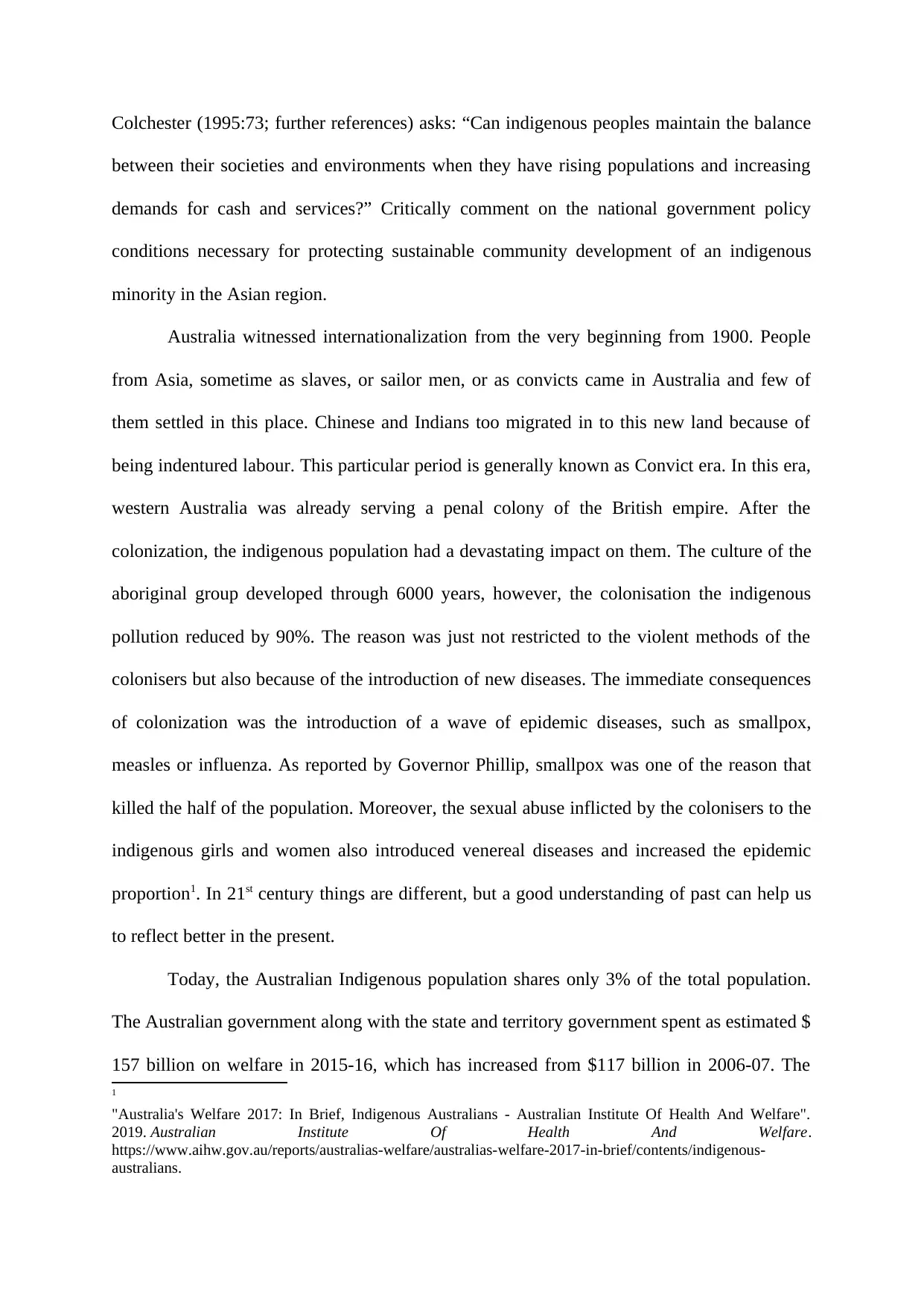
Colchester (1995:73; further references) asks: “Can indigenous peoples maintain the balance
between their societies and environments when they have rising populations and increasing
demands for cash and services?” Critically comment on the national government policy
conditions necessary for protecting sustainable community development of an indigenous
minority in the Asian region.
Australia witnessed internationalization from the very beginning from 1900. People
from Asia, sometime as slaves, or sailor men, or as convicts came in Australia and few of
them settled in this place. Chinese and Indians too migrated in to this new land because of
being indentured labour. This particular period is generally known as Convict era. In this era,
western Australia was already serving a penal colony of the British empire. After the
colonization, the indigenous population had a devastating impact on them. The culture of the
aboriginal group developed through 6000 years, however, the colonisation the indigenous
pollution reduced by 90%. The reason was just not restricted to the violent methods of the
colonisers but also because of the introduction of new diseases. The immediate consequences
of colonization was the introduction of a wave of epidemic diseases, such as smallpox,
measles or influenza. As reported by Governor Phillip, smallpox was one of the reason that
killed the half of the population. Moreover, the sexual abuse inflicted by the colonisers to the
indigenous girls and women also introduced venereal diseases and increased the epidemic
proportion1. In 21st century things are different, but a good understanding of past can help us
to reflect better in the present.
Today, the Australian Indigenous population shares only 3% of the total population.
The Australian government along with the state and territory government spent as estimated $
157 billion on welfare in 2015-16, which has increased from $117 billion in 2006-07. The
1
"Australia's Welfare 2017: In Brief, Indigenous Australians - Australian Institute Of Health And Welfare".
2019. Australian Institute Of Health And Welfare.
https://www.aihw.gov.au/reports/australias-welfare/australias-welfare-2017-in-brief/contents/indigenous-
australians.
between their societies and environments when they have rising populations and increasing
demands for cash and services?” Critically comment on the national government policy
conditions necessary for protecting sustainable community development of an indigenous
minority in the Asian region.
Australia witnessed internationalization from the very beginning from 1900. People
from Asia, sometime as slaves, or sailor men, or as convicts came in Australia and few of
them settled in this place. Chinese and Indians too migrated in to this new land because of
being indentured labour. This particular period is generally known as Convict era. In this era,
western Australia was already serving a penal colony of the British empire. After the
colonization, the indigenous population had a devastating impact on them. The culture of the
aboriginal group developed through 6000 years, however, the colonisation the indigenous
pollution reduced by 90%. The reason was just not restricted to the violent methods of the
colonisers but also because of the introduction of new diseases. The immediate consequences
of colonization was the introduction of a wave of epidemic diseases, such as smallpox,
measles or influenza. As reported by Governor Phillip, smallpox was one of the reason that
killed the half of the population. Moreover, the sexual abuse inflicted by the colonisers to the
indigenous girls and women also introduced venereal diseases and increased the epidemic
proportion1. In 21st century things are different, but a good understanding of past can help us
to reflect better in the present.
Today, the Australian Indigenous population shares only 3% of the total population.
The Australian government along with the state and territory government spent as estimated $
157 billion on welfare in 2015-16, which has increased from $117 billion in 2006-07. The
1
"Australia's Welfare 2017: In Brief, Indigenous Australians - Australian Institute Of Health And Welfare".
2019. Australian Institute Of Health And Welfare.
https://www.aihw.gov.au/reports/australias-welfare/australias-welfare-2017-in-brief/contents/indigenous-
australians.
Paraphrase This Document
Need a fresh take? Get an instant paraphrase of this document with our AI Paraphraser
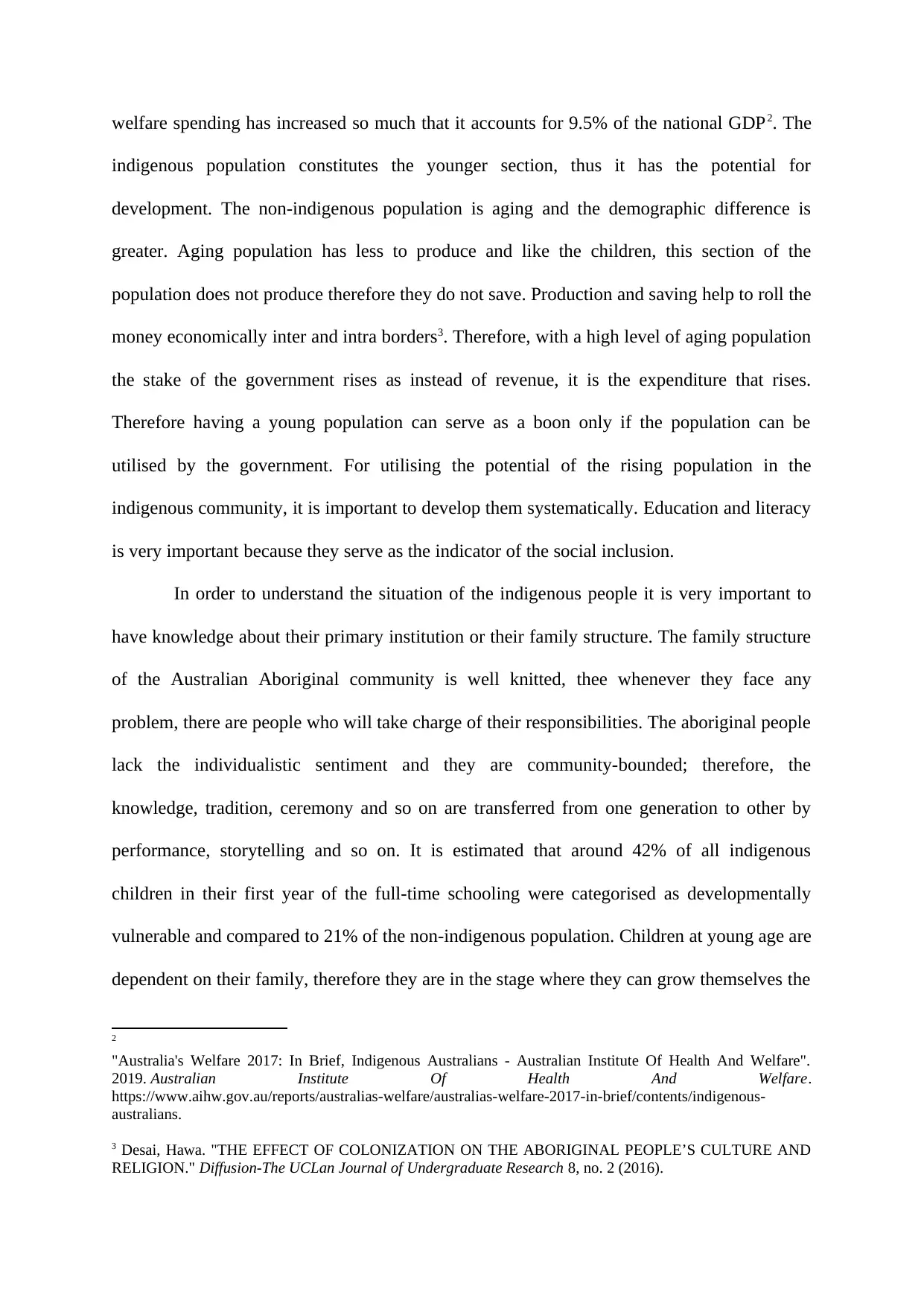
welfare spending has increased so much that it accounts for 9.5% of the national GDP2. The
indigenous population constitutes the younger section, thus it has the potential for
development. The non-indigenous population is aging and the demographic difference is
greater. Aging population has less to produce and like the children, this section of the
population does not produce therefore they do not save. Production and saving help to roll the
money economically inter and intra borders3. Therefore, with a high level of aging population
the stake of the government rises as instead of revenue, it is the expenditure that rises.
Therefore having a young population can serve as a boon only if the population can be
utilised by the government. For utilising the potential of the rising population in the
indigenous community, it is important to develop them systematically. Education and literacy
is very important because they serve as the indicator of the social inclusion.
In order to understand the situation of the indigenous people it is very important to
have knowledge about their primary institution or their family structure. The family structure
of the Australian Aboriginal community is well knitted, thee whenever they face any
problem, there are people who will take charge of their responsibilities. The aboriginal people
lack the individualistic sentiment and they are community-bounded; therefore, the
knowledge, tradition, ceremony and so on are transferred from one generation to other by
performance, storytelling and so on. It is estimated that around 42% of all indigenous
children in their first year of the full-time schooling were categorised as developmentally
vulnerable and compared to 21% of the non-indigenous population. Children at young age are
dependent on their family, therefore they are in the stage where they can grow themselves the
2
"Australia's Welfare 2017: In Brief, Indigenous Australians - Australian Institute Of Health And Welfare".
2019. Australian Institute Of Health And Welfare.
https://www.aihw.gov.au/reports/australias-welfare/australias-welfare-2017-in-brief/contents/indigenous-
australians.
3 Desai, Hawa. "THE EFFECT OF COLONIZATION ON THE ABORIGINAL PEOPLE’S CULTURE AND
RELIGION." Diffusion-The UCLan Journal of Undergraduate Research 8, no. 2 (2016).
indigenous population constitutes the younger section, thus it has the potential for
development. The non-indigenous population is aging and the demographic difference is
greater. Aging population has less to produce and like the children, this section of the
population does not produce therefore they do not save. Production and saving help to roll the
money economically inter and intra borders3. Therefore, with a high level of aging population
the stake of the government rises as instead of revenue, it is the expenditure that rises.
Therefore having a young population can serve as a boon only if the population can be
utilised by the government. For utilising the potential of the rising population in the
indigenous community, it is important to develop them systematically. Education and literacy
is very important because they serve as the indicator of the social inclusion.
In order to understand the situation of the indigenous people it is very important to
have knowledge about their primary institution or their family structure. The family structure
of the Australian Aboriginal community is well knitted, thee whenever they face any
problem, there are people who will take charge of their responsibilities. The aboriginal people
lack the individualistic sentiment and they are community-bounded; therefore, the
knowledge, tradition, ceremony and so on are transferred from one generation to other by
performance, storytelling and so on. It is estimated that around 42% of all indigenous
children in their first year of the full-time schooling were categorised as developmentally
vulnerable and compared to 21% of the non-indigenous population. Children at young age are
dependent on their family, therefore they are in the stage where they can grow themselves the
2
"Australia's Welfare 2017: In Brief, Indigenous Australians - Australian Institute Of Health And Welfare".
2019. Australian Institute Of Health And Welfare.
https://www.aihw.gov.au/reports/australias-welfare/australias-welfare-2017-in-brief/contents/indigenous-
australians.
3 Desai, Hawa. "THE EFFECT OF COLONIZATION ON THE ABORIGINAL PEOPLE’S CULTURE AND
RELIGION." Diffusion-The UCLan Journal of Undergraduate Research 8, no. 2 (2016).
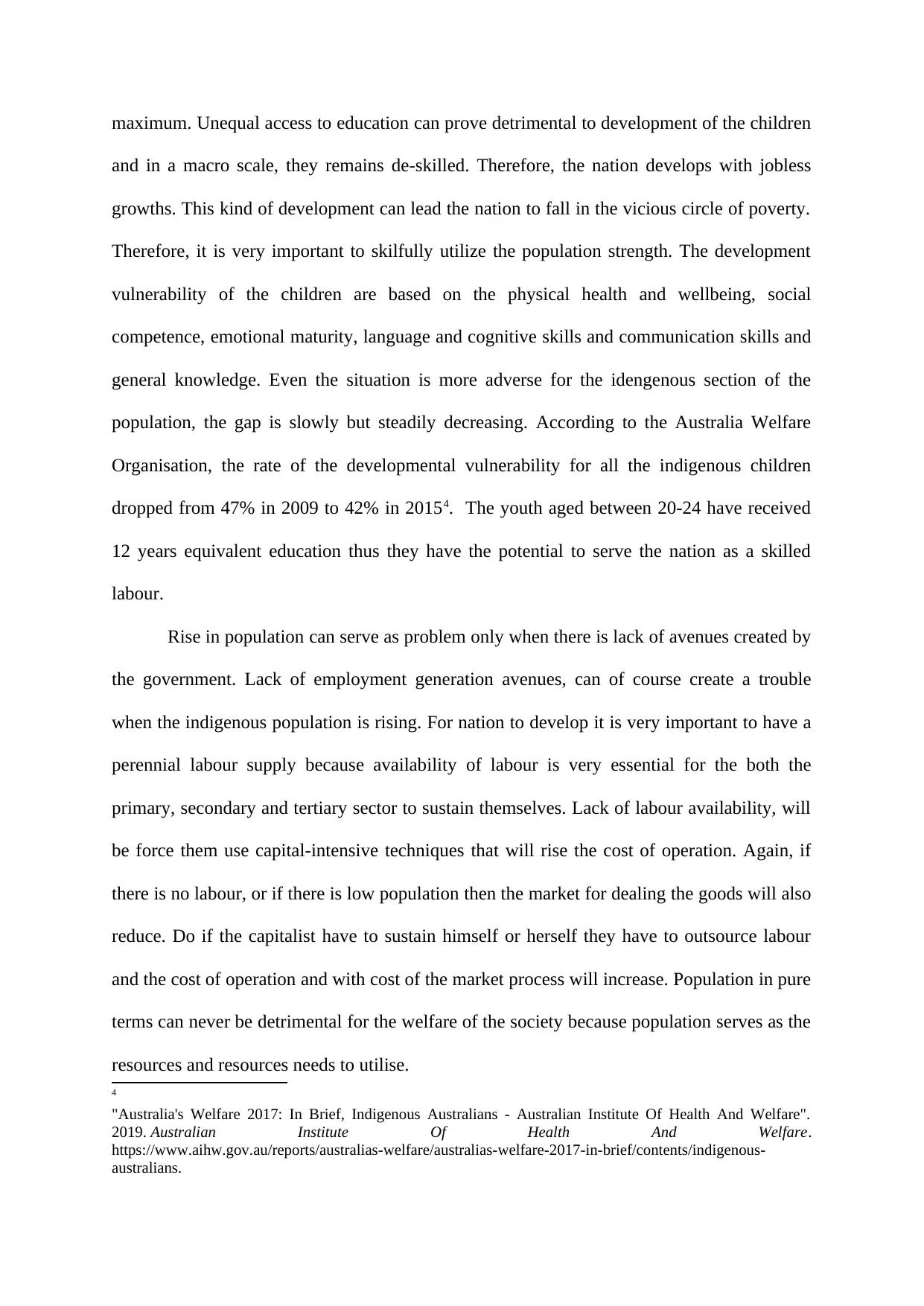
maximum. Unequal access to education can prove detrimental to development of the children
and in a macro scale, they remains de-skilled. Therefore, the nation develops with jobless
growths. This kind of development can lead the nation to fall in the vicious circle of poverty.
Therefore, it is very important to skilfully utilize the population strength. The development
vulnerability of the children are based on the physical health and wellbeing, social
competence, emotional maturity, language and cognitive skills and communication skills and
general knowledge. Even the situation is more adverse for the idengenous section of the
population, the gap is slowly but steadily decreasing. According to the Australia Welfare
Organisation, the rate of the developmental vulnerability for all the indigenous children
dropped from 47% in 2009 to 42% in 20154. The youth aged between 20-24 have received
12 years equivalent education thus they have the potential to serve the nation as a skilled
labour.
Rise in population can serve as problem only when there is lack of avenues created by
the government. Lack of employment generation avenues, can of course create a trouble
when the indigenous population is rising. For nation to develop it is very important to have a
perennial labour supply because availability of labour is very essential for the both the
primary, secondary and tertiary sector to sustain themselves. Lack of labour availability, will
be force them use capital-intensive techniques that will rise the cost of operation. Again, if
there is no labour, or if there is low population then the market for dealing the goods will also
reduce. Do if the capitalist have to sustain himself or herself they have to outsource labour
and the cost of operation and with cost of the market process will increase. Population in pure
terms can never be detrimental for the welfare of the society because population serves as the
resources and resources needs to utilise.
4
"Australia's Welfare 2017: In Brief, Indigenous Australians - Australian Institute Of Health And Welfare".
2019. Australian Institute Of Health And Welfare.
https://www.aihw.gov.au/reports/australias-welfare/australias-welfare-2017-in-brief/contents/indigenous-
australians.
and in a macro scale, they remains de-skilled. Therefore, the nation develops with jobless
growths. This kind of development can lead the nation to fall in the vicious circle of poverty.
Therefore, it is very important to skilfully utilize the population strength. The development
vulnerability of the children are based on the physical health and wellbeing, social
competence, emotional maturity, language and cognitive skills and communication skills and
general knowledge. Even the situation is more adverse for the idengenous section of the
population, the gap is slowly but steadily decreasing. According to the Australia Welfare
Organisation, the rate of the developmental vulnerability for all the indigenous children
dropped from 47% in 2009 to 42% in 20154. The youth aged between 20-24 have received
12 years equivalent education thus they have the potential to serve the nation as a skilled
labour.
Rise in population can serve as problem only when there is lack of avenues created by
the government. Lack of employment generation avenues, can of course create a trouble
when the indigenous population is rising. For nation to develop it is very important to have a
perennial labour supply because availability of labour is very essential for the both the
primary, secondary and tertiary sector to sustain themselves. Lack of labour availability, will
be force them use capital-intensive techniques that will rise the cost of operation. Again, if
there is no labour, or if there is low population then the market for dealing the goods will also
reduce. Do if the capitalist have to sustain himself or herself they have to outsource labour
and the cost of operation and with cost of the market process will increase. Population in pure
terms can never be detrimental for the welfare of the society because population serves as the
resources and resources needs to utilise.
4
"Australia's Welfare 2017: In Brief, Indigenous Australians - Australian Institute Of Health And Welfare".
2019. Australian Institute Of Health And Welfare.
https://www.aihw.gov.au/reports/australias-welfare/australias-welfare-2017-in-brief/contents/indigenous-
australians.
⊘ This is a preview!⊘
Do you want full access?
Subscribe today to unlock all pages.

Trusted by 1+ million students worldwide
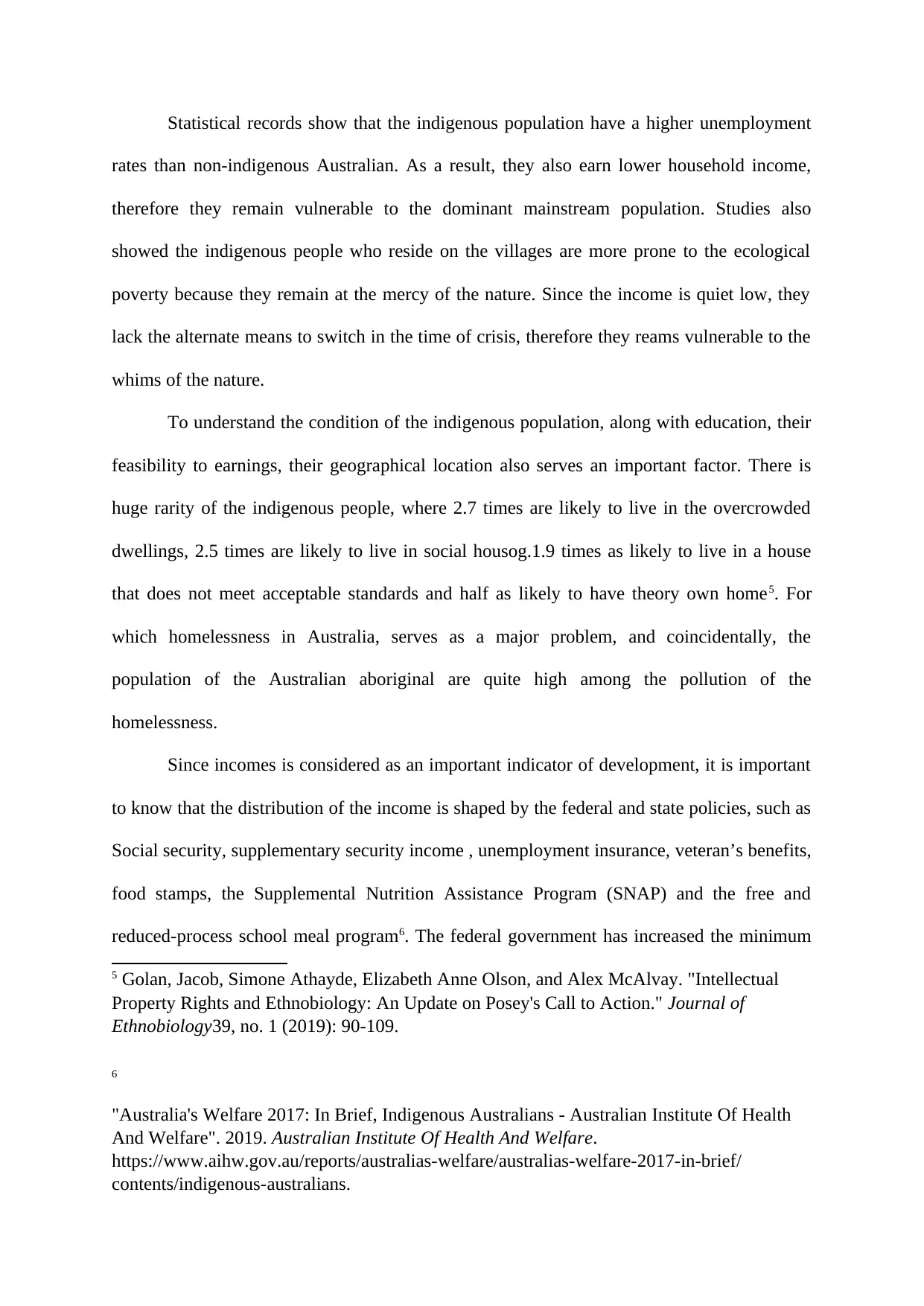
Statistical records show that the indigenous population have a higher unemployment
rates than non-indigenous Australian. As a result, they also earn lower household income,
therefore they remain vulnerable to the dominant mainstream population. Studies also
showed the indigenous people who reside on the villages are more prone to the ecological
poverty because they remain at the mercy of the nature. Since the income is quiet low, they
lack the alternate means to switch in the time of crisis, therefore they reams vulnerable to the
whims of the nature.
To understand the condition of the indigenous population, along with education, their
feasibility to earnings, their geographical location also serves an important factor. There is
huge rarity of the indigenous people, where 2.7 times are likely to live in the overcrowded
dwellings, 2.5 times are likely to live in social housog.1.9 times as likely to live in a house
that does not meet acceptable standards and half as likely to have theory own home5. For
which homelessness in Australia, serves as a major problem, and coincidentally, the
population of the Australian aboriginal are quite high among the pollution of the
homelessness.
Since incomes is considered as an important indicator of development, it is important
to know that the distribution of the income is shaped by the federal and state policies, such as
Social security, supplementary security income , unemployment insurance, veteran’s benefits,
food stamps, the Supplemental Nutrition Assistance Program (SNAP) and the free and
reduced-process school meal program6. The federal government has increased the minimum
5 Golan, Jacob, Simone Athayde, Elizabeth Anne Olson, and Alex McAlvay. "Intellectual
Property Rights and Ethnobiology: An Update on Posey's Call to Action." Journal of
Ethnobiology39, no. 1 (2019): 90-109.
6
"Australia's Welfare 2017: In Brief, Indigenous Australians - Australian Institute Of Health
And Welfare". 2019. Australian Institute Of Health And Welfare.
https://www.aihw.gov.au/reports/australias-welfare/australias-welfare-2017-in-brief/
contents/indigenous-australians.
rates than non-indigenous Australian. As a result, they also earn lower household income,
therefore they remain vulnerable to the dominant mainstream population. Studies also
showed the indigenous people who reside on the villages are more prone to the ecological
poverty because they remain at the mercy of the nature. Since the income is quiet low, they
lack the alternate means to switch in the time of crisis, therefore they reams vulnerable to the
whims of the nature.
To understand the condition of the indigenous population, along with education, their
feasibility to earnings, their geographical location also serves an important factor. There is
huge rarity of the indigenous people, where 2.7 times are likely to live in the overcrowded
dwellings, 2.5 times are likely to live in social housog.1.9 times as likely to live in a house
that does not meet acceptable standards and half as likely to have theory own home5. For
which homelessness in Australia, serves as a major problem, and coincidentally, the
population of the Australian aboriginal are quite high among the pollution of the
homelessness.
Since incomes is considered as an important indicator of development, it is important
to know that the distribution of the income is shaped by the federal and state policies, such as
Social security, supplementary security income , unemployment insurance, veteran’s benefits,
food stamps, the Supplemental Nutrition Assistance Program (SNAP) and the free and
reduced-process school meal program6. The federal government has increased the minimum
5 Golan, Jacob, Simone Athayde, Elizabeth Anne Olson, and Alex McAlvay. "Intellectual
Property Rights and Ethnobiology: An Update on Posey's Call to Action." Journal of
Ethnobiology39, no. 1 (2019): 90-109.
6
"Australia's Welfare 2017: In Brief, Indigenous Australians - Australian Institute Of Health
And Welfare". 2019. Australian Institute Of Health And Welfare.
https://www.aihw.gov.au/reports/australias-welfare/australias-welfare-2017-in-brief/
contents/indigenous-australians.
Paraphrase This Document
Need a fresh take? Get an instant paraphrase of this document with our AI Paraphraser
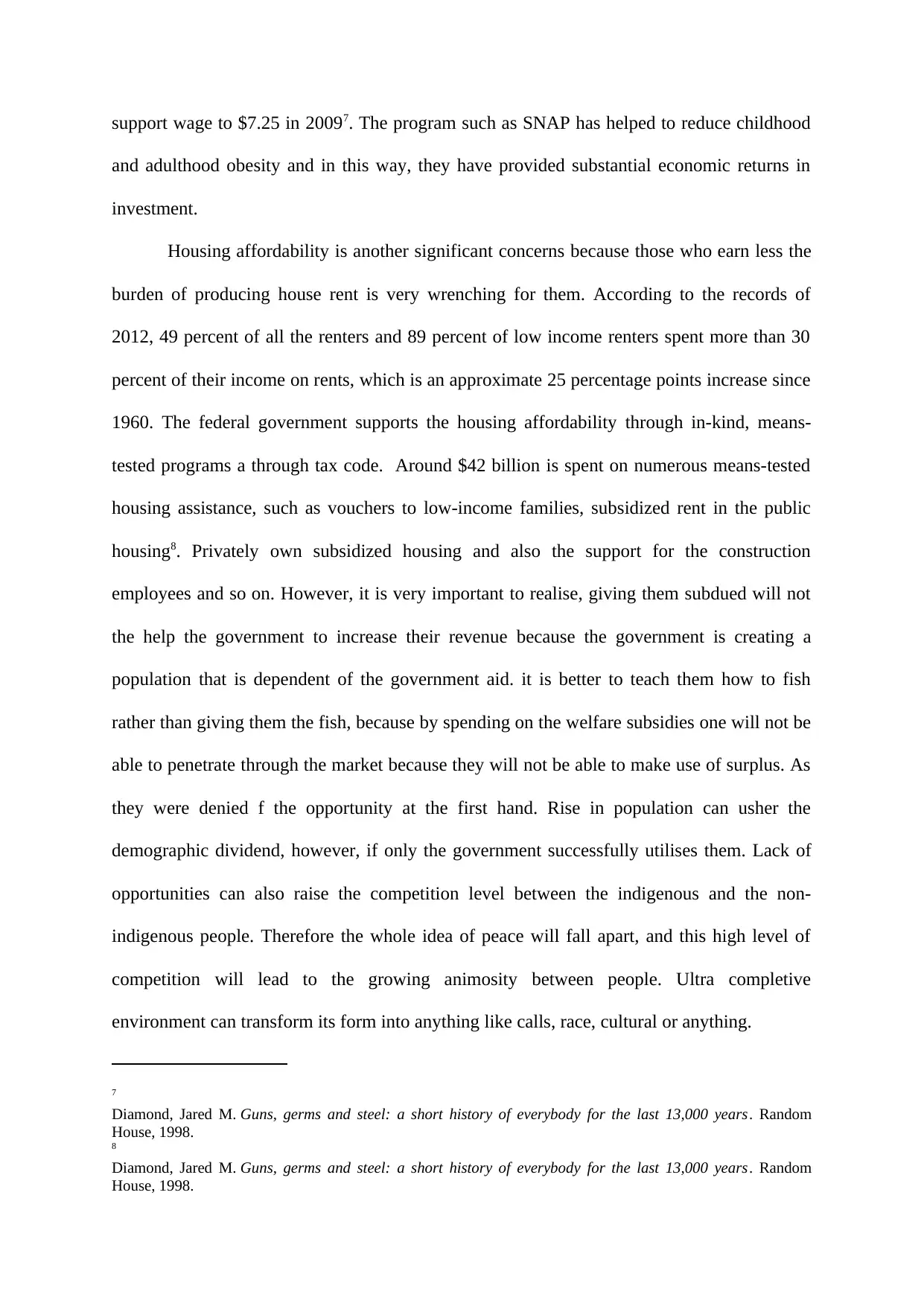
support wage to $7.25 in 20097. The program such as SNAP has helped to reduce childhood
and adulthood obesity and in this way, they have provided substantial economic returns in
investment.
Housing affordability is another significant concerns because those who earn less the
burden of producing house rent is very wrenching for them. According to the records of
2012, 49 percent of all the renters and 89 percent of low income renters spent more than 30
percent of their income on rents, which is an approximate 25 percentage points increase since
1960. The federal government supports the housing affordability through in-kind, means-
tested programs a through tax code. Around $42 billion is spent on numerous means-tested
housing assistance, such as vouchers to low-income families, subsidized rent in the public
housing8. Privately own subsidized housing and also the support for the construction
employees and so on. However, it is very important to realise, giving them subdued will not
the help the government to increase their revenue because the government is creating a
population that is dependent of the government aid. it is better to teach them how to fish
rather than giving them the fish, because by spending on the welfare subsidies one will not be
able to penetrate through the market because they will not be able to make use of surplus. As
they were denied f the opportunity at the first hand. Rise in population can usher the
demographic dividend, however, if only the government successfully utilises them. Lack of
opportunities can also raise the competition level between the indigenous and the non-
indigenous people. Therefore the whole idea of peace will fall apart, and this high level of
competition will lead to the growing animosity between people. Ultra completive
environment can transform its form into anything like calls, race, cultural or anything.
7
Diamond, Jared M. Guns, germs and steel: a short history of everybody for the last 13,000 years. Random
House, 1998.
8
Diamond, Jared M. Guns, germs and steel: a short history of everybody for the last 13,000 years. Random
House, 1998.
and adulthood obesity and in this way, they have provided substantial economic returns in
investment.
Housing affordability is another significant concerns because those who earn less the
burden of producing house rent is very wrenching for them. According to the records of
2012, 49 percent of all the renters and 89 percent of low income renters spent more than 30
percent of their income on rents, which is an approximate 25 percentage points increase since
1960. The federal government supports the housing affordability through in-kind, means-
tested programs a through tax code. Around $42 billion is spent on numerous means-tested
housing assistance, such as vouchers to low-income families, subsidized rent in the public
housing8. Privately own subsidized housing and also the support for the construction
employees and so on. However, it is very important to realise, giving them subdued will not
the help the government to increase their revenue because the government is creating a
population that is dependent of the government aid. it is better to teach them how to fish
rather than giving them the fish, because by spending on the welfare subsidies one will not be
able to penetrate through the market because they will not be able to make use of surplus. As
they were denied f the opportunity at the first hand. Rise in population can usher the
demographic dividend, however, if only the government successfully utilises them. Lack of
opportunities can also raise the competition level between the indigenous and the non-
indigenous people. Therefore the whole idea of peace will fall apart, and this high level of
competition will lead to the growing animosity between people. Ultra completive
environment can transform its form into anything like calls, race, cultural or anything.
7
Diamond, Jared M. Guns, germs and steel: a short history of everybody for the last 13,000 years. Random
House, 1998.
8
Diamond, Jared M. Guns, germs and steel: a short history of everybody for the last 13,000 years. Random
House, 1998.
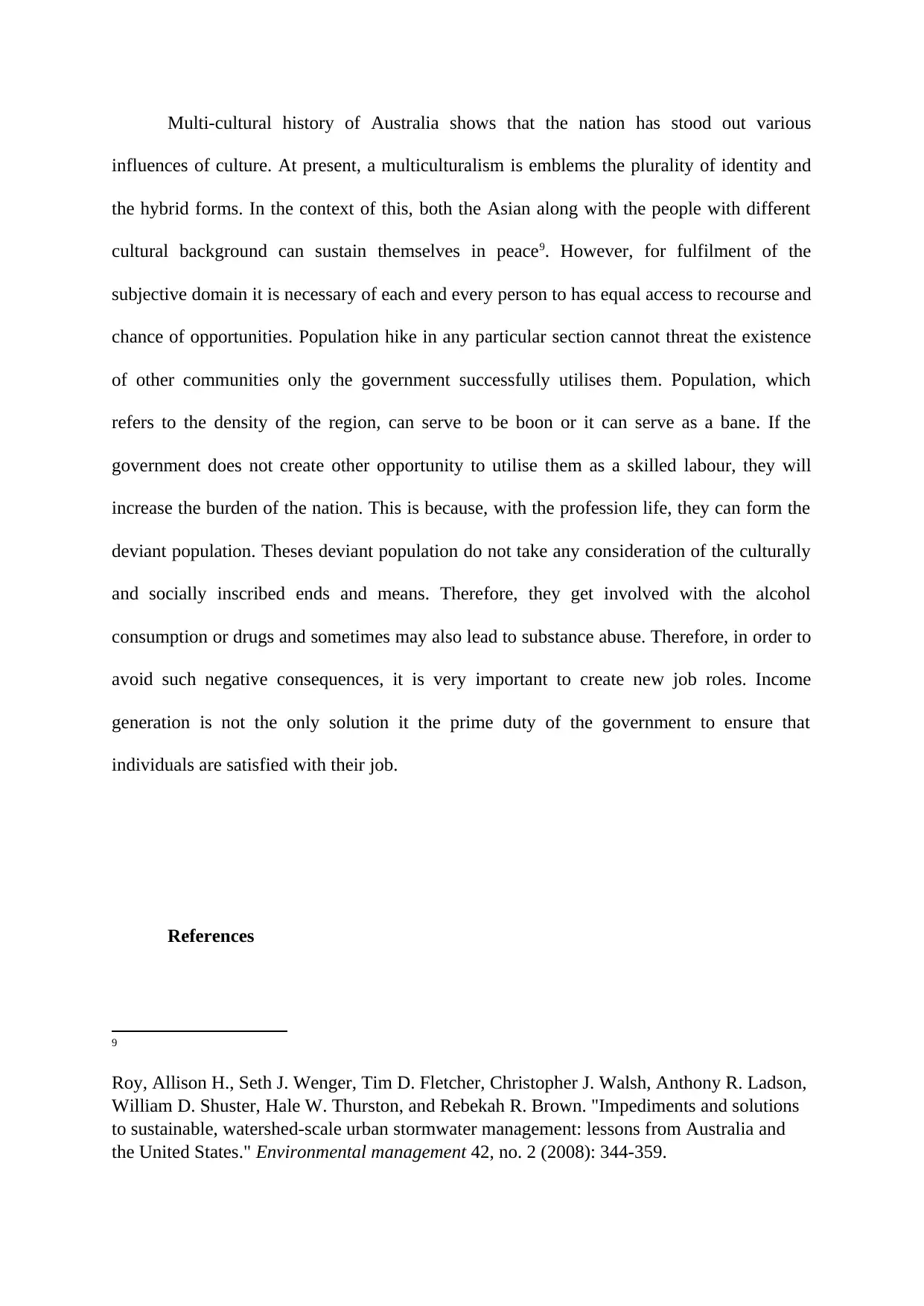
Multi-cultural history of Australia shows that the nation has stood out various
influences of culture. At present, a multiculturalism is emblems the plurality of identity and
the hybrid forms. In the context of this, both the Asian along with the people with different
cultural background can sustain themselves in peace9. However, for fulfilment of the
subjective domain it is necessary of each and every person to has equal access to recourse and
chance of opportunities. Population hike in any particular section cannot threat the existence
of other communities only the government successfully utilises them. Population, which
refers to the density of the region, can serve to be boon or it can serve as a bane. If the
government does not create other opportunity to utilise them as a skilled labour, they will
increase the burden of the nation. This is because, with the profession life, they can form the
deviant population. Theses deviant population do not take any consideration of the culturally
and socially inscribed ends and means. Therefore, they get involved with the alcohol
consumption or drugs and sometimes may also lead to substance abuse. Therefore, in order to
avoid such negative consequences, it is very important to create new job roles. Income
generation is not the only solution it the prime duty of the government to ensure that
individuals are satisfied with their job.
References
9
Roy, Allison H., Seth J. Wenger, Tim D. Fletcher, Christopher J. Walsh, Anthony R. Ladson,
William D. Shuster, Hale W. Thurston, and Rebekah R. Brown. "Impediments and solutions
to sustainable, watershed-scale urban stormwater management: lessons from Australia and
the United States." Environmental management 42, no. 2 (2008): 344-359.
influences of culture. At present, a multiculturalism is emblems the plurality of identity and
the hybrid forms. In the context of this, both the Asian along with the people with different
cultural background can sustain themselves in peace9. However, for fulfilment of the
subjective domain it is necessary of each and every person to has equal access to recourse and
chance of opportunities. Population hike in any particular section cannot threat the existence
of other communities only the government successfully utilises them. Population, which
refers to the density of the region, can serve to be boon or it can serve as a bane. If the
government does not create other opportunity to utilise them as a skilled labour, they will
increase the burden of the nation. This is because, with the profession life, they can form the
deviant population. Theses deviant population do not take any consideration of the culturally
and socially inscribed ends and means. Therefore, they get involved with the alcohol
consumption or drugs and sometimes may also lead to substance abuse. Therefore, in order to
avoid such negative consequences, it is very important to create new job roles. Income
generation is not the only solution it the prime duty of the government to ensure that
individuals are satisfied with their job.
References
9
Roy, Allison H., Seth J. Wenger, Tim D. Fletcher, Christopher J. Walsh, Anthony R. Ladson,
William D. Shuster, Hale W. Thurston, and Rebekah R. Brown. "Impediments and solutions
to sustainable, watershed-scale urban stormwater management: lessons from Australia and
the United States." Environmental management 42, no. 2 (2008): 344-359.
⊘ This is a preview!⊘
Do you want full access?
Subscribe today to unlock all pages.

Trusted by 1+ million students worldwide
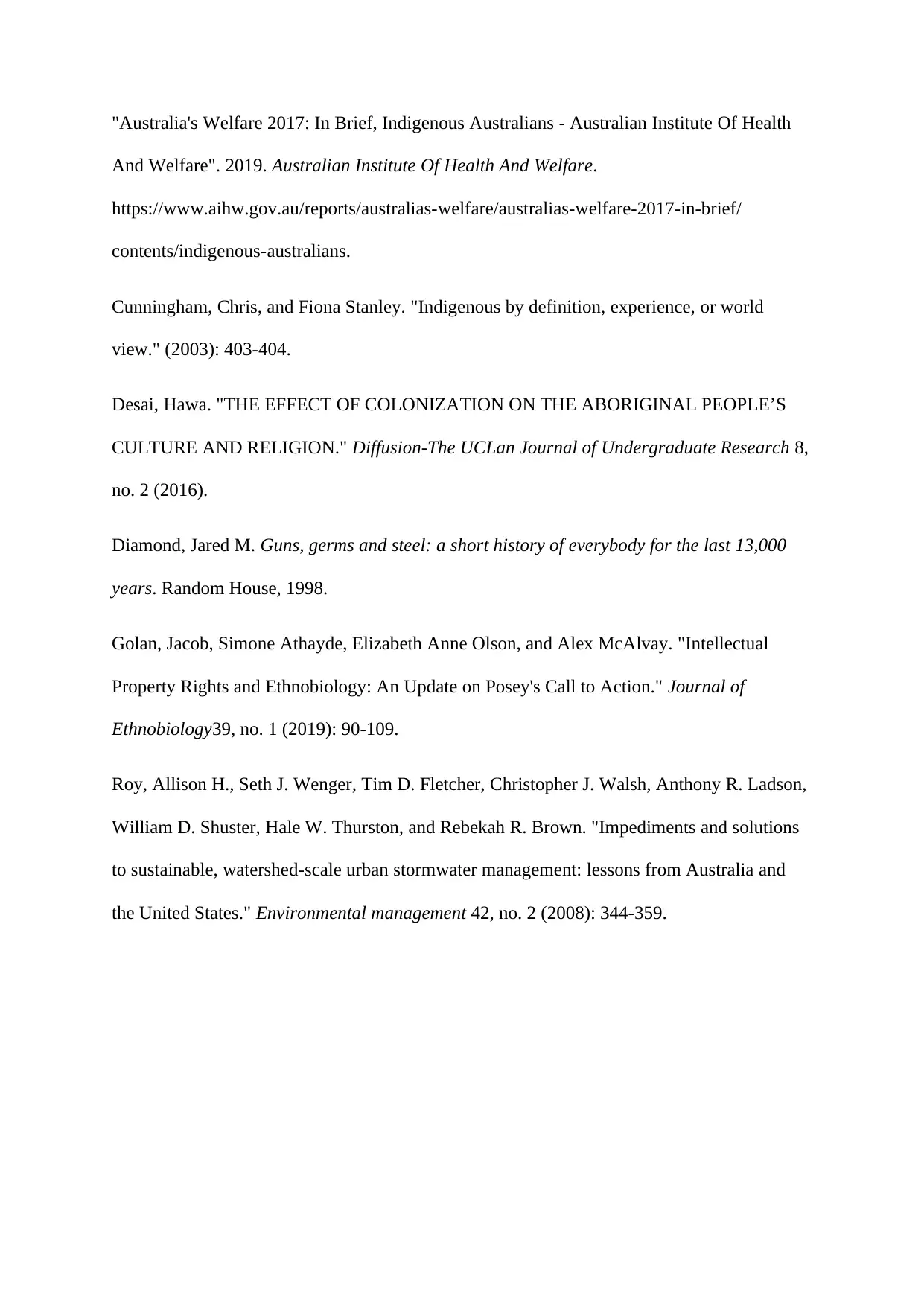
"Australia's Welfare 2017: In Brief, Indigenous Australians - Australian Institute Of Health
And Welfare". 2019. Australian Institute Of Health And Welfare.
https://www.aihw.gov.au/reports/australias-welfare/australias-welfare-2017-in-brief/
contents/indigenous-australians.
Cunningham, Chris, and Fiona Stanley. "Indigenous by definition, experience, or world
view." (2003): 403-404.
Desai, Hawa. "THE EFFECT OF COLONIZATION ON THE ABORIGINAL PEOPLE’S
CULTURE AND RELIGION." Diffusion-The UCLan Journal of Undergraduate Research 8,
no. 2 (2016).
Diamond, Jared M. Guns, germs and steel: a short history of everybody for the last 13,000
years. Random House, 1998.
Golan, Jacob, Simone Athayde, Elizabeth Anne Olson, and Alex McAlvay. "Intellectual
Property Rights and Ethnobiology: An Update on Posey's Call to Action." Journal of
Ethnobiology39, no. 1 (2019): 90-109.
Roy, Allison H., Seth J. Wenger, Tim D. Fletcher, Christopher J. Walsh, Anthony R. Ladson,
William D. Shuster, Hale W. Thurston, and Rebekah R. Brown. "Impediments and solutions
to sustainable, watershed-scale urban stormwater management: lessons from Australia and
the United States." Environmental management 42, no. 2 (2008): 344-359.
And Welfare". 2019. Australian Institute Of Health And Welfare.
https://www.aihw.gov.au/reports/australias-welfare/australias-welfare-2017-in-brief/
contents/indigenous-australians.
Cunningham, Chris, and Fiona Stanley. "Indigenous by definition, experience, or world
view." (2003): 403-404.
Desai, Hawa. "THE EFFECT OF COLONIZATION ON THE ABORIGINAL PEOPLE’S
CULTURE AND RELIGION." Diffusion-The UCLan Journal of Undergraduate Research 8,
no. 2 (2016).
Diamond, Jared M. Guns, germs and steel: a short history of everybody for the last 13,000
years. Random House, 1998.
Golan, Jacob, Simone Athayde, Elizabeth Anne Olson, and Alex McAlvay. "Intellectual
Property Rights and Ethnobiology: An Update on Posey's Call to Action." Journal of
Ethnobiology39, no. 1 (2019): 90-109.
Roy, Allison H., Seth J. Wenger, Tim D. Fletcher, Christopher J. Walsh, Anthony R. Ladson,
William D. Shuster, Hale W. Thurston, and Rebekah R. Brown. "Impediments and solutions
to sustainable, watershed-scale urban stormwater management: lessons from Australia and
the United States." Environmental management 42, no. 2 (2008): 344-359.
1 out of 7
Related Documents
Your All-in-One AI-Powered Toolkit for Academic Success.
+13062052269
info@desklib.com
Available 24*7 on WhatsApp / Email
![[object Object]](/_next/static/media/star-bottom.7253800d.svg)
Unlock your academic potential
Copyright © 2020–2025 A2Z Services. All Rights Reserved. Developed and managed by ZUCOL.





